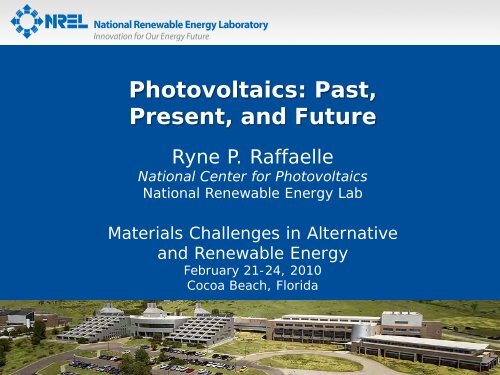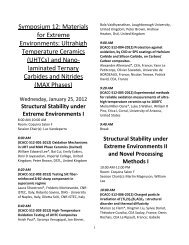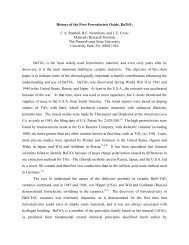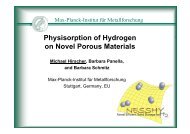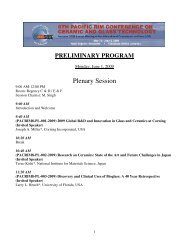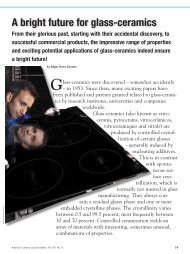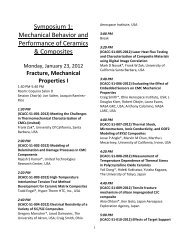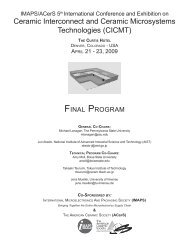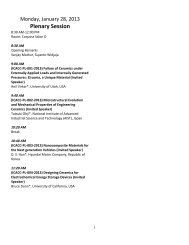Photovoltaics: Past, Present, and Future
Photovoltaics: Past, Present, and Future
Photovoltaics: Past, Present, and Future
You also want an ePaper? Increase the reach of your titles
YUMPU automatically turns print PDFs into web optimized ePapers that Google loves.
<strong>Photovoltaics</strong>: <strong>Past</strong>,<br />
<strong>Present</strong>, <strong>and</strong> <strong>Future</strong><br />
Ryne P. Raffaelle<br />
National Center for <strong>Photovoltaics</strong><br />
National Renewable Energy Lab<br />
Materials Challenges in Alternative<br />
<strong>and</strong> Renewable Energy<br />
February 21-24, 2010<br />
Cocoa Beach, Florida
<strong>Photovoltaics</strong> (PV)<br />
Solar Power<br />
Concentrating Solar Power<br />
(CSP)
Solar Cell Fundamentals
Solar Cell Fundamentals<br />
Shockley-Quiesser Limit for a single junction solar<br />
cell is 32%<br />
window<br />
p<br />
emitter<br />
n<br />
base<br />
window<br />
E c<br />
E f<br />
E v
Solar Cell Fundamentals
Solar Cell Fundamentals<br />
W. Shockley & H.J. Queisser, J.<br />
Appl. Phys. 32, 510 (1961)<br />
(S. Kurtz <strong>and</strong> D. Friedman, NREL)
V 1<br />
V 2<br />
V 3<br />
Multi-junction solar cell<br />
Multijunction Solar Cells<br />
load
Photovoltaic Timeline<br />
• 1839 – photovoltaic effect first recognized<br />
• 1883 – first solar cell created<br />
• 1946 - modern pn junction solar cell<br />
• 1954 – doped silicon first used in solar cells<br />
• 1958 - first spacecraft to use solar panels<br />
• 1970 – GaAs solar cells created<br />
• 1989 – first dual junction cell created<br />
• 1993 - first dual junction cells for spacecraft<br />
• 1995 – 30% efficiency barrier broken<br />
• 2004 – terrestrial solar cell production exceeds 1 GW<br />
• 2009 – 40% efficiency barrier broken
World Record PV Efficiencies<br />
NREL Technology Breakthroughs<br />
NREL Current World Records<br />
NREL<br />
NREL<br />
NREL<br />
NREL<br />
NREL<br />
NREL<br />
NREL<br />
NREL<br />
NREL<br />
NREL<br />
NREL<br />
NREL
1958 Vanguard 1<br />
Explorer 1 – Van Allen<br />
1962 Telstar (14 kW)<br />
Starfish<br />
1973 Orbital<br />
Workshop Array on<br />
Skylab (6 kW, LEO)<br />
History of Space <strong>Photovoltaics</strong><br />
1993 MJ III-V<br />
Solar Cell<br />
2008 Inverted<br />
Metamorphic<br />
Solar Cell<br />
1998 SCARLETT ARRAY<br />
on Deep Space 1<br />
2009 ISS Solar Array<br />
Completed<br />
2000 Boeing<br />
702 failures
• Solar Energy Research<br />
Institute (1974)<br />
• Begins operation in<br />
(1977)<br />
• Reagan cuts budget by<br />
90%<br />
National Center for <strong>Photovoltaics</strong><br />
• SERI becomes<br />
National Lab (1991)<br />
• National Renewable<br />
Energy Lab (NREL<br />
• National Center for<br />
<strong>Photovoltaics</strong> (NCPV)<br />
established in 1996<br />
NCPV
National Center for <strong>Photovoltaics</strong><br />
The National Center for <strong>Photovoltaics</strong> (NCPV) focuses on innovations in PV<br />
technology that drive industry growth in U.S. photovoltaic manufacturing.<br />
It is directed to use the resources <strong>and</strong> capabilities of the national labs <strong>and</strong><br />
universities for the benefit of the U.S. PV industry.<br />
The NCPV charge is to accelerate PV as a viable energy option in the U.S.
PV Facilities at NREL<br />
Science & Technology Facility<br />
Outdoor Test Facility<br />
Solar Energy Research Facility<br />
Process Development <strong>and</strong> Integration Lab
NREL’s SETP is aligned with the DOE SETP<br />
DOE<br />
Solar Energy<br />
Technology<br />
Program<br />
<strong>Photovoltaics</strong> (PV)<br />
Concentrating<br />
Solar Power (CSP)<br />
System Integration<br />
Distributed Generation<br />
- on-site or near point of use<br />
-<br />
Market Transformation<br />
Centralized Generation<br />
- large users or utilities -<br />
Ed Etzkon: Tuesday, 2:40 PM, Sea Oats
2015 Goals:<br />
Residential 8-10 ¢/kWh<br />
Commercial 6-8 ¢/kWh<br />
Utility 5-7 ¢/kWh<br />
DOE SETP Goals<br />
Cost Competitive<br />
Target<br />
Cost Cost<br />
($/W)<br />
Reliabilit<br />
y y<br />
Performance<br />
$ / W p $/Watt of Module Price vs Efficiency <strong>and</strong> $/m2 Costs<br />
Efficiency $ / m 2<br />
Reliability<br />
Cost ($/W) Performance
Wafers<br />
Crystalline Si<br />
Poly X-tal Si<br />
III-V<br />
PV Technology Portfolio<br />
Thin Films<br />
a-Si<br />
CdTe<br />
CIGS<br />
Polymeric<br />
Concentrators<br />
Low X<br />
High X<br />
Portable
PV Opportunities in the U.S.<br />
•The US has the largest solar resource of any industrialized<br />
country in the world.<br />
• Developing the technology <strong>and</strong> industrial base to harness this<br />
resource is the key to the transformation “green economy” <strong>and</strong> the<br />
US economic recovery.<br />
PV Industry Roadmap – US DOE
Average insolation<br />
kWh/m 2 /day<br />
Global Solar Energy Resource
Solar Energy Potential<br />
3 TW<br />
Source: Nathan S. Lewis, California Institute of Technology
Solar Energy Potential<br />
6 Boxes at 3.3 TW Each<br />
Worldwide Solar Energy<br />
Theoretical: 120,000 TW<br />
Energy in 1 hour of sunlight ≡ 14 TW<br />
Practical: ≈ 600 TW<br />
Source: Nathan S. Lewis, California Institute of Technology
Size Matters
Efficiency<br />
10% 20% 30% 40%<br />
3.6 TW US Consumption<br />
Source: Nathan S. Lewis, California Institute of Technology
Source: Energy Information Administration,<br />
Annual Energy Outlook 2006, Table D4<br />
U.S. Energy Consumption <strong>and</strong><br />
the Role of Renewable Energy
�<br />
Growth of Global PV Industry
US PV Market Share
Cumulative Installed Capacity (MW)<br />
4,000<br />
3,500<br />
3,000<br />
2,500<br />
2,000<br />
1,500<br />
1,000<br />
500<br />
-<br />
Global PV Deployment<br />
1992<br />
1993<br />
1994<br />
1995<br />
1996<br />
1997<br />
1998<br />
1999<br />
2000<br />
2001<br />
2002<br />
2003<br />
2004<br />
2005<br />
2006<br />
2007<br />
Germany<br />
Japan<br />
US<br />
Spain<br />
Italy<br />
Korea<br />
France<br />
Australia
Global PV Deployment
Global PV Production
Cost versus Production<br />
http://www.energy.soton.ac.uk/solar/solar.html
PV Learning Curve
Public data from SEC, analysts, etc.<br />
Agenda Slide (Arial Narrow, 28 pt)<br />
= Q3 2009 Price<br />
= End-of-Year 2010<br />
Price
PV News ‘08 Actual 6.9 GW<br />
Navigant ‘08 Actual 5.4 GW<br />
PV Production Status<br />
* Goldman projection<br />
is for dem<strong>and</strong><br />
** Navigant projection<br />
is for accelerated case
Policy Driven Scenarios<br />
Source: U.S. Dept. of Energy
Predicted PV Revenues<br />
The PV industry has grown at CAGR of ~ 45% over the last decade.
U.S. Production Trends<br />
Source: U.S. Dept. of Energy
Predicted PV Revenues
Cost Cost of of Materials Materials Limit Limit (20% (20% Modules)<br />
Modules)<br />
PV module prices have followed an experience curve with a slope of ~<br />
80% (a 20% decrease in price with every doubling of cumulative<br />
production).
DOE EERE Charge: Making<br />
PV More Sustainable<br />
Economical<br />
• Raw materials usage<br />
• Abundant Materials<br />
• Manufacturability<br />
• Efficiency<br />
• Durability<br />
• Market Assessment<br />
Environmentally Safe<br />
• Non-toxic alternatives<br />
• Aqueous based materials<br />
• Re-use, Reman, Recycle<br />
• Environmental Impact Assessment<br />
Societal<br />
• Reliability<br />
• Building Integrated (BIPV)<br />
• Productization<br />
Sustainable development is<br />
development that meets the<br />
needs of the present without<br />
compromising the ability of<br />
future generations to meet<br />
their own needs – UN<br />
Bruntl<strong>and</strong> Commission
S<strong>and</strong><br />
Energy <strong>and</strong> Si-intensive wafers<br />
Add Carbon &<br />
Heat Energy<br />
CO2<br />
Waste ~1/2<br />
in sawing<br />
metallurgical<br />
grade Si<br />
Add more heat<br />
energy (1500°C)<br />
pure<br />
SiHCl<br />
3<br />
or<br />
SiH4<br />
Add Heat Energy<br />
(1000 °C)<br />
silicon<br />
feedstock<br />
Use 10X<br />
more than<br />
needed • ~ 2 yr energy payback<br />
• $0.60/W - $1.00/W for feedstock alone
Thin Film PV<br />
Ascent Solar<br />
•Amorphous Si (aSi)<br />
•CdTe<br />
•Cu(In,Ga)Se 2 (CIGS)
BIPV<br />
42
Comparison of Production Costs for<br />
Conventional Silicon <strong>and</strong> CdTe Thin Film Modules<br />
Silicon<br />
$2.10/W<br />
Encapsulation<br />
27%<br />
Cell<br />
24%<br />
Feedstock 23%<br />
Ingot 12%<br />
Wafer 14%<br />
Encapsulation<br />
50%<br />
CdTe<br />
$1.10/W<br />
Coated Glass<br />
29%<br />
Materials 3%<br />
Equipment 13%<br />
Operating 5%
S<strong>and</strong><br />
HWCVD is<br />
best low-T<br />
scalable<br />
technique<br />
Vision for Si wafer replacement<br />
Add Carbon &<br />
Heat Energy<br />
CO2<br />
NREL Si Group: H. Branz, MRS 2009<br />
metallurgical<br />
grade Si<br />
44<br />
pure<br />
SiHCl3<br />
or<br />
SiH4<br />
Directly deposit<br />
enough pure silicon<br />
for light absorption
Concentrating <strong>Photovoltaics</strong><br />
> 40% Efficient
Inverted Metamorphic Solar Cell<br />
• Creation of a fundamentally new technology path, the inverted lattice-mismatched (IMM) cell.<br />
This cell design resulted in the new 1 sun solar cell efficiency record (33.8%). Also, this<br />
technology allowed NREL to break the 40% AM1.5 photovoltaic conversion efficiency barrier<br />
under concentration! This technology shatters all records related to specific power (~3000<br />
W/kg) (enabling for a host of PV spin-off applications, man portable energy scavenging, space<br />
power systems).<br />
• Remarkably rapid transfer of the technology to industry. RF Micro Devices, Emcore, Spectrolab,<br />
Microlink.<br />
• R&D 100 Award <strong>and</strong> the 2009 Federal Laboratory Consortium Award for Excellence in<br />
Technology Transfer.
Next Generation PV<br />
• Metamorphic Growth<br />
• Inverted Metamorphic Growth<br />
• 4, 5, … Junction Devices<br />
• Dilute Nitride Devices<br />
• Poly III-V<br />
• Mechanical Stacking<br />
• Optical Spectrum Splitting<br />
• Concentrator Designs<br />
• QM B<strong>and</strong>gap Engineering<br />
• IBSC<br />
η from 30% to 40% <strong>and</strong> beyond?<br />
Emcore
3 rd Generation Solar Cells<br />
Source: Martin Green, UNSW
Alternative Paths to High Efficiency<br />
Barnham, Imperial<br />
College<br />
e<br />
e<br />
E g<br />
E c<br />
E v<br />
Multiple Exciton Generation<br />
– Multiple excitons<br />
generated from a single<br />
excited electron by impact<br />
ionization<br />
e<br />
e<br />
E c<br />
E v<br />
Down Converter – Convert<br />
one high energy photon into<br />
one or more convertible<br />
photons<br />
SK Growth of III-V<br />
Quantum Dots<br />
S.M. Hubbard, et al, Appl. Phys.<br />
Lett 92, 123512 (2008)<br />
Solar<br />
Cell<br />
Intermediate B<strong>and</strong> – Presence of<br />
partially filled Intermediate<br />
B<strong>and</strong> allows multiple photon<br />
collection paths, including two<br />
photon processes<br />
e<br />
E c<br />
E v<br />
Up Converter – Convert two<br />
(or more) unusable lowenergy<br />
photons (red) into a<br />
single convertible photon<br />
(blue).<br />
e<br />
e<br />
e<br />
E c<br />
IB<br />
E v
Working with the NCPV<br />
Incubator<br />
New Pre-Incubator<br />
Technology Pathway Partnerships<br />
PV Supply Chain<br />
<strong>Future</strong> Generation Program<br />
PV Manufacturing Initiative<br />
TPPs<br />
Ammonix<br />
Sunpower<br />
Soliant<br />
General Electric<br />
Konarka<br />
Nanosolar<br />
BP Solar<br />
Greenray<br />
Unisolar<br />
Dow Chemical<br />
Ind. CRADAs<br />
Plextronics<br />
SiXtron<br />
Corning/Varian<br />
Incubator<br />
Calsiolar<br />
Sol Focus<br />
MicroLink Devices<br />
SoloPower<br />
Primestar<br />
AVA Solar<br />
Plextronics<br />
Innovalight<br />
Spire Solar<br />
Solexel<br />
1366 Technologies<br />
Solasta<br />
Skyline<br />
Pre-Incubator<br />
Banyan Energy<br />
Crystal Solar<br />
ISET<br />
TiSol<br />
Ascent Solar Technologies<br />
EPIR Technologies<br />
MicroLink Devices<br />
1366 Technologies<br />
Lightwave Power<br />
Vanguard Solar<br />
Semprius<br />
SpectraWatt<br />
Luna Innovations<br />
Universities<br />
Toledo<br />
Delaware<br />
Florida<br />
Arizona State<br />
Cal Tech<br />
RIT<br />
MIT<br />
Penn State<br />
Georgia Tech<br />
Stanford<br />
UC Davis<br />
CSM<br />
Colorado<br />
Colorado State<br />
Illinois<br />
Michigan<br />
South Florida<br />
Washington<br />
Next Gen<br />
Wakonda<br />
Voxtel<br />
Solasta<br />
Solexant<br />
Soltaix<br />
Voxtel<br />
NREL T&E<br />
1366 Technologies<br />
3M<br />
AMONIX<br />
ADCO<br />
Advent Solar<br />
Applied Materials<br />
Applied Optical Sciences<br />
BASF<br />
BP Solar<br />
BRP Manufacturing<br />
Dow Chemical<br />
CaliSolar<br />
Dupont<br />
First Solar<br />
GT Solar<br />
Infoscitex<br />
Innovalight<br />
Konarka<br />
NanoSolar<br />
PrimeStar<br />
Solar Power Industries<br />
SolFocus<br />
Schott Solar<br />
Skyline Solar<br />
Spectrolab (Boeing)<br />
SunPower<br />
TruSeal<br />
Uni-Solar
Questions?<br />
Visit us online at www.nrel.gov<br />
National Renewable Energy<br />
Operated for the U.S. Department of Energy Office of Energy Efficiency <strong>and</strong> Renewable Energy<br />
Laboratory<br />
Innovation for Our Energy <strong>Future</strong>


